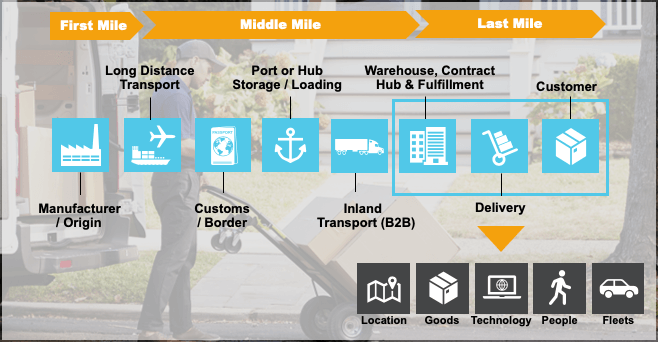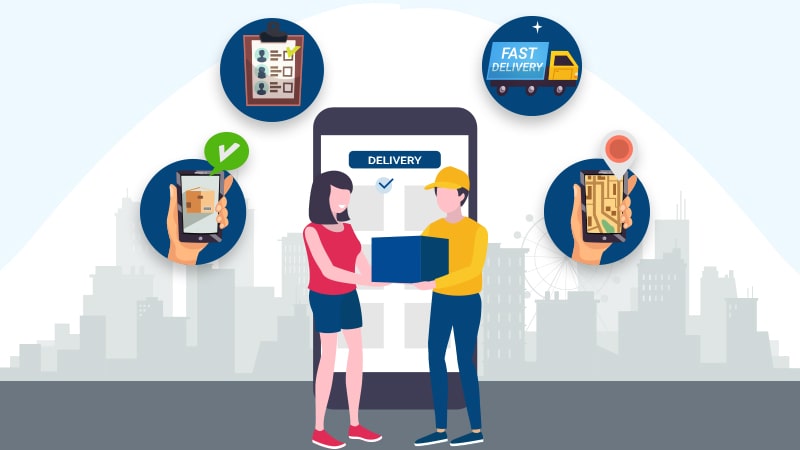With global eCommerce sales expected to surpass $6.5 billion by 2023, now is the time to establish, optimize, and solidify your last mile delivery processes. Read on for a close look at what last mile delivery entails, the latest challenges and trends, and how to select a last mile delivery service provider.
What is Last Mile Delivery?
The supply chain process involves three major milestones:

First mile is the distribution of an item from the manufacturer.
Middle mile involves long-distance transportation and includes going through customs, port or hub storage and loading, and inland transportation. (For domestic orders, not all of these steps are necessary.) It brings products to the final station before being loaded onto vehicles for delivery.
Last mile, sometimes called final mile, is where the item is sent out from a local warehouse or fulfillment center for its final delivery to the customer.
Every step of the supply chain process is crucial, but last mile is where the most impact can be made for the customer experience. If a product arrives late, damaged, or is never delivered, there is a good chance that the customer will shop with a competitor next time. Essentially, last mile is where the business brings their values, their brand, and their promise to the customer’s door.
Why Last Mile is Vital to eCommerce Operations
Companies like Amazon have created a culture of immediacy. In the U.S. alone, there are over 112 million Amazon Prime members, all of whom expect free two-day shipping on their orders (or in some areas, even one day or same-day shipping).
It is hard to beat that, and businesses can spread themselves too thin attempting to do so. But what Amazon Prime has shown is that customers are willing to pay more for faster delivery. Businesses can compete by ensuring that their eCommerce operations and strategies are 100% customer focused. Here are a few ways:
Omnichannel Supply Chains
Omnichannel operations give customers options for purchases and returns by integrating all sales outlets.
Customers can place an order from a computer, mobile web browser, mobile app, phone, or in-store. Then they can choose to receive their products through at-home delivery or by picking them up in the store. Returns can be made by visiting the store or by mailing the items back to the merchant.
Inventory Forecasting
Deliveries cannot be made quickly if the products are not in stock. Using inventory management and forecasting tools, retailers can spot trends in customers’ purchase habits and use that information to forecast demand. Based on this forecast, items can be moved to nearby fulfillment centers, so they are available and ready for fast delivery.
What Are the Operational Costs of Last Mile Delivery?
Without vehicles, customers cannot receive their orders, which is why a reliable fleet of transportation vehicles is a necessity for last mile delivery fulfillment. How companies acquire these vehicles is where many unnecessary operating expenses arise.
Companies like Postmates and Amazon Flex rely on crowdsourcing and gig economy workers, which involves recruiting independent drivers. Upfront, this seems like a cost-effective method. The drivers are not considered full-time employees and they use their own vehicles. However, this is an unreliable means to an end, as independent drivers are less efficient, hard to find, inconsistent, and may use older vehicles. These factors can end up tarnishing your brand image.
Many companies also rely on daily car rentals for busy days, which carry high costs and little to no stability. With rentals, there are also limitations to the types of vehicles available. If customers are expecting large packages, like furniture or electronics, you need to have a vehicle that can fit the items securely. If a rental company only has sedans in stock, this could delay delivery times.
The most cost-efficient and flexible solution is to lease vehicles — on either a short-term or long-term basis — from a fleet management provider. This guarantees that you have the exact vehicles you need, whenever you need them. A fleet partner ensures that your vehicles are well-maintained, optimized for your customers’ delivery needs, and branded to your company’s specifications.
A study by Capgemini found that last mile deliveries cost businesses an average of $10.10 per customer, but customers only pay an average of $8.08. The demand for quick deliveries will only increase in the coming years, which makes minimizing operational costs all the more important for retailers.
Challenges with Last Mile Delivery
In addition to costs, last mile deliveries pose other unique challenges.
Traveling in Urban Areas
If you have ever driven through a big city, you know that the roads are narrow, traffic is a nightmare, and parking is near impossible. This makes deliveries a bit more time-consuming than they would be in the suburbs, which can lead to significant delays.
Traveling in Rural Areas
On the other hand, rural locations have nothing but space which is also a problem. Drivers may need to travel miles in between stops, increasing travel times and wait times.
Delivering Large and Heavy Items
Anything can be ordered online, including bulky items like furniture. Ideally, there will be two delivery persons to carry the large item to the customer’s doorstep, but this is not always the case. Either way, the logistics of getting the item out of the truck can be time-consuming.
Lack of Drivers and Vehicles
Even before the coronavirus caused delivery personnel to become essential workers, the U.S. was facing a driver shortage. As we mentioned earlier, many businesses are also relying on costly ad hoc vehicle acquisitions. However, with the continual surge of eCommerce, these as-needed vehicles may soon need to turn into leases.
Trends in Last Mile Delivery
Unique challenges call for unique solutions. The industry is continually introducing new strategies to get products into the hands of customers more quickly and cost-effectively.
Pop Up Warehouses
Business Insider states that last mile delivery accounts for 53% of shipping and transportation costs. By relocating products into pop up warehouses that are closer to customers, retailers can significantly reduce transportation costs.
Drones and Robots
While not yet widely adopted, self-driving vehicles and drones could soon become an industry game changer. In California, a pilot program involving Nuro, a self-driving delivery vehicle, and Kroger, the largest supermarket chain in the U.S., is already well under way. This technology would help solve the delivery driver shortage, while also making 24/7/365 deliveries possible.
Last Mile Technology Solutions
Vehicles equipped with telematics and GPS tracking technology provide valuable insights into fleet operations. Vehicle diagnostics, driver behaviors, and trip data are aggregated into a centralized system to help fleet managers identify key areas for cost savings and safety improvements. Telematics can detect unsafe driving habits, offer route optimizations for quicker deliveries, and ensure that vehicles are kept up to date on maintenance to maximize uptime.
Advanced Order Tracking
Nearly every merchant provides updates to customers when orders are received and shipped. The more high-tech providers send step-by-step updates. For example, Amazon Prime customers receive mobile alerts when packages are a few stops away, and even maps that show exactly where the driver is.
White Glove Delivery
Customers who order heavy items or pieces that require assembly may be inclined to purchase white glove services. This involves the delivery person(s) unpacking and assembling a product for an additional fee. If you outsource your last mile deliveries, there are third-party transportation companies that offer this service.
How to Choose a Last Mile Delivery Service Provider
Amazon is not the only company that can succeed with last mile delivery. Businesses can take advantage of the expanding market by establishing their own delivery network or partnering with a third-party transportation company.
Whatever the route, consider the following while strategizing a last mile delivery plan:
Reviews
Online reviews will tell you almost everything you need to know about a company. Check Google, social media accounts, and the company’s website to see what other people’s experience with the company has been like.
Technology
As we have covered in this article, technology is driving the future of last mile delivery. From advanced order tracking to driverless deliveries, technology is revolutionizing the way customers receive their orders while also making it easier and more cost-effective for retailers to deliver these orders. Last mile service providers should understand the importance of technology and offer relevant strategies to propel a retailer forward.
Fleet
What vehicles are available? A third-party provider will already have an existing fleet, but is it right for your operations? Class 5 trucks can transport a lot of items, but can they maneuver throughout downtown city streets where many of your customers live? If the plan is to establish a delivery network, working with a fleet management company is the most efficient way to get the right vehicles.
If you have questions about fleet management or how you can improve your last mile delivery services, contact us! We are always happy to help.
Source: https://www.merchantsfleet.com
CUT COTS OF THE FLEET WITH OUR AUDIT PROGRAM
The audit is a key tool to know the overall status and provide the analysis, the assessment, the advice, the suggestions and the actions to take in order to cut costs and increase the efficiency and efficacy of the fleet. We propose the following fleet management audit.




